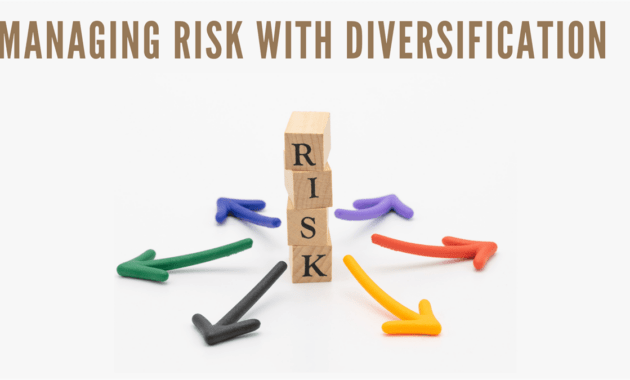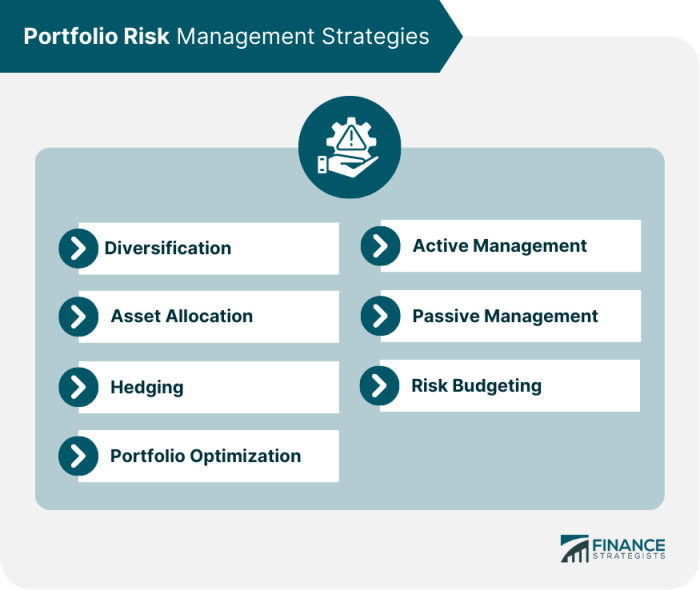Risk Management and Diversification take the spotlight in the world of finance, offering a strategic approach to navigating investment uncertainties and optimizing returns. Dive into the realm of minimizing risks and maximizing gains with this comprehensive guide.
Explore the intricacies of risk management strategies, the importance of diversification, and how to effectively mitigate potential pitfalls in your investment journey.
Introduction to Risk Management and Diversification
Risk management and diversification are crucial concepts in the world of finance, especially when it comes to investment portfolios.
Risk management involves identifying, assessing, and prioritizing risks, followed by coordinating resources to minimize, monitor, and control the impact of these risks. It is essential for investors to have a solid risk management strategy in place to protect their investments from potential losses.
Diversification, on the other hand, refers to spreading your investments across different assets or asset classes to reduce exposure to any single asset or risk. By diversifying your portfolio, you can potentially minimize the overall risk and volatility, as losses from one investment may be offset by gains in another.
The Importance of Risk Management in Investment Portfolios
Effective risk management is crucial for investment portfolios as it helps investors protect their capital from unpredictable market fluctuations and unforeseen events. By identifying and analyzing risks, investors can make informed decisions to mitigate potential losses and preserve the value of their investments.
- Risk management allows investors to set clear objectives and guidelines for their investments, helping them stay focused on their long-term financial goals.
- By implementing risk management strategies, investors can reduce the impact of market volatility and economic downturns on their portfolios.
- Proper risk management can also help investors avoid making impulsive decisions based on emotions, ensuring a disciplined approach to investing.
The Benefits of Diversification in Minimizing Risk
Diversification plays a key role in minimizing risk within an investment portfolio by spreading investments across different asset classes, industries, or regions. This strategy can help investors achieve a more balanced and resilient portfolio that is less susceptible to the fluctuations of any single investment.
- Diversification can reduce the overall risk of a portfolio by ensuring that losses from one investment are offset by gains in others, leading to a more stable return over time.
- By diversifying across various assets, investors can potentially increase the likelihood of capturing positive returns from different market conditions or economic cycles.
- Furthermore, diversification can help investors avoid overexposure to specific risks or sectors, providing a level of protection against unforeseen events that may impact a particular asset class.
Strategies for Risk Management
Risk management is a crucial aspect of investment strategy, aimed at minimizing potential losses and maximizing returns. There are various strategies that investors can employ to manage risks effectively.
Asset Allocation:
One common risk management strategy is asset allocation, which involves spreading investments across different asset classes such as stocks, bonds, and real estate. By diversifying one’s portfolio, investors can reduce the impact of market fluctuations on their overall investment performance.
Active vs. Passive Risk Management:
Another important consideration is the choice between active and passive risk management approaches. Active risk management involves frequent trading and adjustments to the portfolio in response to market conditions, while passive risk management involves maintaining a more static approach to investment allocation. Both approaches have their own benefits and drawbacks, depending on the investor’s risk tolerance and investment goals.
Utilizing Derivatives:
Derivatives are financial instruments that derive their value from an underlying asset or index, such as options, futures, and swaps. These instruments can be used effectively for risk management purposes, such as hedging against potential losses or speculating on market movements. For example, an investor can use options to protect their portfolio from downside risk or to generate additional income through covered call strategies.
In conclusion, risk management is a key component of successful investing, and understanding and implementing various strategies such as asset allocation, active vs. passive risk management, and the use of derivatives can help investors mitigate risks and achieve their financial goals.
Types of Risks in Investment

Investing in the financial market involves various types of risks that can impact the performance of investment portfolios. It is essential for investors to understand and analyze these risks to make informed decisions and mitigate potential losses.
Market Risk
Market risk, also known as systematic risk, is the potential for investments to be affected by broader market movements such as economic conditions, political events, interest rates, and market volatility. This type of risk can impact the value of investments across different asset classes, leading to losses in the portfolio.
Credit Risk
Credit risk refers to the possibility of loss arising from the failure of a borrower to repay a debt or meet financial obligations. This risk is prevalent in bond investments or any other form of debt securities. A downgrade in credit rating or default by the issuer can result in significant losses for investors holding these securities.
Liquidity Risk
Liquidity risk is the risk of not being able to sell an investment quickly at a fair price. Investments with low liquidity may have wider bid-ask spreads, making it challenging to exit a position without impacting the market price. This risk can lead to losses if investors need to sell assets urgently during periods of market stress.
Risk Assessment Framework
To analyze and manage different types of risks in investment portfolios, investors can design a risk assessment framework that includes:
– Identifying and quantifying each type of risk present in the portfolio
– Establishing risk tolerance levels based on investment objectives and time horizon
– Implementing diversification strategies to spread risk across different asset classes
– Monitoring and adjusting the risk exposure as market conditions change
Diversification Techniques

Diversification is a crucial strategy in risk management, aimed at reducing the overall risk of a portfolio by spreading investments across different assets. One key concept in diversification is correlation, which measures the relationship between the returns of two investments. Understanding correlation is essential in constructing a well-diversified portfolio.
Correlation and its Role in Diversification
Correlation is a statistical measure that ranges from -1 to 1, indicating the degree to which two assets move in relation to each other.
- Assets with a correlation coefficient of 1 move in perfect harmony, which means they are highly correlated.
- Assets with a correlation coefficient of -1 move in opposite directions, providing a strong diversification benefit.
- Assets with a correlation coefficient close to 0 have little to no relationship, offering maximum diversification benefits.
Strategies for Effective Portfolio Diversification, Risk Management and Diversification
Effective portfolio diversification involves spreading investments across different asset classes, industries, and geographic regions.
- Allocate investments among various asset classes such as stocks, bonds, real estate, and commodities to reduce exposure to specific risks.
- Diversify within asset classes by investing in a mix of large-cap, mid-cap, and small-cap stocks to balance risk and return potential.
- Consider investing in different industries to mitigate sector-specific risks that can impact your portfolio.
International Investments for Diversification
International investments can be used as a diversification strategy to reduce country-specific risks and benefit from global economic growth.
- Investing in international stocks provides exposure to different economies and currencies, reducing the impact of domestic market fluctuations.
- Consider investing in emerging markets to diversify your portfolio further and potentially benefit from higher growth rates compared to developed markets.
Risk Management Tools and Instruments: Risk Management And Diversification

Risk management tools and instruments play a crucial role in helping investors safeguard their portfolios from potential financial losses. Let’s explore the use of options and futures, the role of insurance, and the effectiveness of stop-loss orders in risk management.
Options and Futures in Risk Management
Options and futures are derivative instruments that allow investors to hedge against potential losses in the financial markets. Options give the holder the right, but not the obligation, to buy or sell an asset at a predetermined price within a specified time frame. Futures contracts, on the other hand, obligate the buyer and seller to transact the asset at a set price on a future date.
- Options provide flexibility to investors by offering protection against adverse price movements in the market.
- Futures contracts help in managing price risk by locking in a future price for an asset, thereby reducing uncertainty.
- Both options and futures can be used to hedge against market volatility and mitigate potential losses.
Insurance in Mitigating Financial Risks
Insurance plays a crucial role in risk management by providing financial protection against unforeseen events that could lead to losses. Whether it’s health insurance, property insurance, or liability insurance, having the right coverage can help investors mitigate financial risks effectively.
- Insurance policies help transfer the risk of potential losses to an insurance company, providing peace of mind to investors.
- By paying a premium, investors can protect themselves against events such as natural disasters, accidents, or lawsuits.
- Having adequate insurance coverage is essential for managing financial risks and ensuring financial stability.
Stop-Loss Orders in Risk Management
Stop-loss orders are tools used by investors to limit their losses in the financial markets. These orders automatically sell a security when it reaches a predetermined price, helping investors control their risk exposure and protect their investment capital.
- Stop-loss orders help investors set predefined exit points to limit their losses in case the market moves against their position.
- By using stop-loss orders, investors can manage their risk and protect their portfolios from significant downturns in the market.
- Implementing stop-loss orders is a proactive risk management strategy that can help investors minimize losses and preserve capital.
Summary
In conclusion, Risk Management and Diversification serve as powerful tools in safeguarding your investments and achieving long-term financial success. By understanding the nuances of risk assessment and diversification techniques, you can steer your portfolio towards stability and growth.
When it comes to day trading stocks, it’s crucial to have the best strategies in place to maximize your profits. One of the most effective strategies is to focus on high volatility stocks, as they offer more opportunities for quick gains.
Another key strategy is to set strict stop-loss limits to protect your capital. Additionally, having a solid understanding of technical analysis can help you make more informed trading decisions. To learn more about the best strategies for day trading stocks, check out this comprehensive guide here.
When it comes to day trading stocks, having the best strategies in place is crucial for success. Whether you’re a beginner or a seasoned trader, knowing the right techniques can make a significant difference in your profits. From technical analysis to risk management, the best strategies for day trading stocks involve a combination of research, discipline, and patience.
By understanding market trends and using the right tools, you can maximize your gains and minimize your losses in the fast-paced world of day trading.

